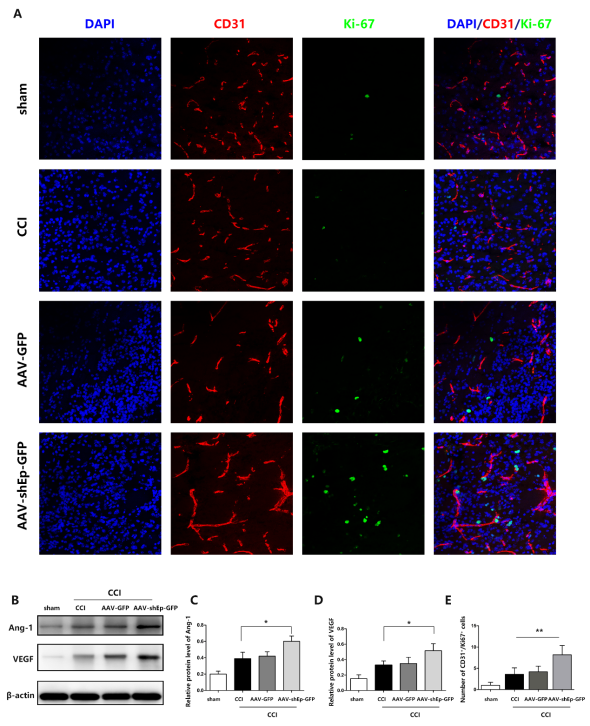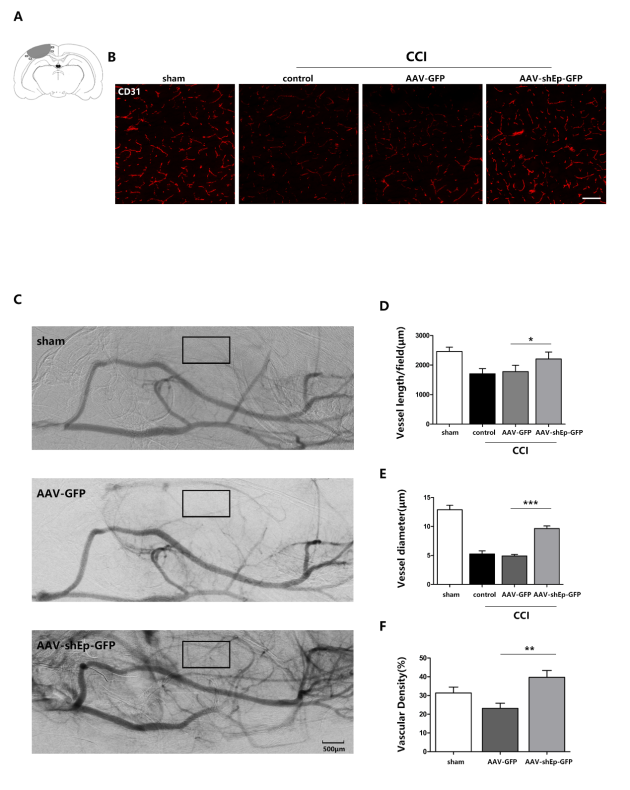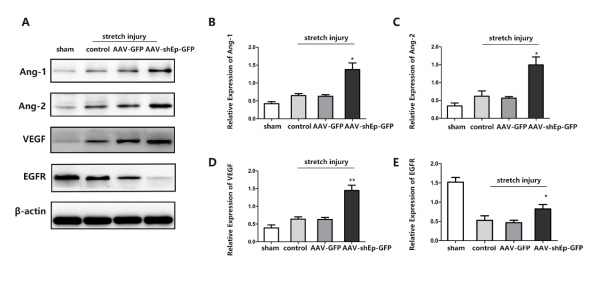NRR:上海交通大学徐志明团队揭示抑制endorepellin表达可促进创伤性脑损伤后功能性血管新生和神经功能恢复
撰文:张倩,荆尧,龚秋源,田恒力,丁军,徐志明
颅内血管丧失或功能障碍是创伤性脑损伤(traumatic brain injury, TBI)特征性表现之一,几乎伴随TBI全病理过程,对TBI患者的结局及神经功能恢复具有重要意义[1-2]。TBI损伤灶周围新生血管不仅为损伤脑组织区域带来氧气和养料,同时参与了神经功能修复及白质重塑[3]。临床研究中亦发现TBI患者脑组织内血管新生程度与神经功能改善关系密切。Endorepellin是串珠素(perlecan)C端片段,广泛存在于基底膜中,有研究表明endorepellin参与肿瘤的生物学进程,并与肌肉组织流失等病理生理过程相关。但血管内皮细胞仍是endorepellin最主要发挥生物作用对象,其可通过影响多条信号通路改变细胞的氧化应激水平、成管能力,并最终发挥拮抗血管生成作用[4]。然而,endorepellin在TBI后血管新生的作用仍缺乏相关研究。
近日,上海交通大学徐志明团队在《中国神经再生研究(英文版)》(Neural Regeneration Research)上发表了题为“Endorepellin downregulation promotes angiogenesis and neurological function in mice after experimental traumatic brain injury”的文章。研究发现下调endorepellin表达可以促进小鼠损伤灶周围血管新生并改善小鼠TBI后神经功能恢复,利用同步辐射进行活体小鼠脑血管造影进一步提示endorepellin表达下调后损伤灶周围新生微血管密度较对照组显著提升,且存在灌注功能的血管显著增加。体外实验中,人脐静脉内皮细胞(human umbilical vein endothelial cells, HUVECs)在低表达endorepellin后细胞成管能力显著增强,进一步探究发现,低表达endorepellin促进内皮细胞成管能力的潜在机制可能与血管生成素1(angiopoietin-1, Ang-1)及血管内皮生长因子(vascular endothelial growth factor, VEGF)相关通路有关。探究调控endorepellin表达水平影响TBI小鼠损伤灶周围功能性血管新生作用及其潜在的分子机制,可为探索促进TBI后微血管新生及神经功能损伤修复提供新的靶点。
TBI发生后,多种原发性及继发性损伤机制发挥作用,导致损伤灶周围微血管损伤及丢失[5]。实验首先观察了TBI小鼠皮层endorepellin随时间变化表达改变,结果表明,TBI后7-14天endorepellin的表达水平达到高峰。既往的研究表明,endorepellin可以影响血管内皮细胞的凋亡和自噬水平,进而抑制血管新生[6-7]。并通过慢病毒转染敲减小鼠脑组织endorepellin后TBI小鼠损伤灶周围血管新生水平显著增加(图1)。利用同步辐射检测活体小鼠微血管灌注情况则发现,endorepellin低表达组小鼠TBI后存在灌注功能的微血管密度较对照组显著升高,这一结果表明微血管新生不仅是数量上的增加,而且功能性即存在灌注功能的微血管数量增加(图2)。在体外实验中,课题组发现慢病毒转染后的HUVECs成管能力显著增强,这一现象可能与endorepellin影响促血管新生相关因子表达有关(图3)。

图1 敲减endorepellin后TBI小鼠损伤灶周围新生血管数量显著增高。(图源:Qian Z, et al., Neural Regen Res, 2024)

图2 利用同步辐射检测TBI小鼠14天后损伤灶周围新生血管密度及灌注功能,敲减endorepellin显著提高了损伤灶周围微血管密度,存在灌注功能的血管亦显著增加。(图源:Qian Z, et al., Neural Regen Res, 2024)
 #br#
#br#
图3 Endorepellin敲减后,HUVECs促血管生成相关蛋白表达升高。(图源:Qian Z, et al., Neural Regen Res, 2024)
总之,敲减endorepellin对小鼠TBI后损伤灶周围功能性微血管新生能力非常重要。作者的研究表明,endorepellin的表达在TBI后脑组织表达随时间逐渐增高,虽然既往有关于endorepellin主要作用于血管内皮细胞见诸报道,但这一变化对TBI后微血管新生作用尚不明确,在缺血性脑卒中模型中,endorepellin的作用甚至存在争议。因此,课题组在体内外以病毒转染的方式低表达endorepellin。结果证实,敲减endorepellin不仅可以促进损伤灶周围微血管新生,且功能性微血管新生亦显著增加,TBI后小鼠神经功能恢复能力升高。体外实验中,HUVECs细胞在敲减endorepellin后成管能力增强,细胞内相关促血管新生因子表达上升有关,这可能是敲减endorepellin发挥促功能性血管新生的潜在机制。此项研究结果将为促进TBI后功能性血管新生治疗策略提供基础。
当然该研究也存在一定性局限性。首先,该研究只关注了TBI后雄性小鼠恢复期血管新生情况。为提高临床的临床意义,未来的研究应该考虑在各组采用随机的方式使用雌性小鼠,此外,还应注意探索敲减endorepellin后对小鼠TBI后急性期神经生物学的影响。在体外实验中,采用的是人脐静脉内皮细胞,如果使用原代小鼠脑微血管内皮细胞,则更具说服力。最后,研究在具体机制的探索仍具有一定的局限性。
原文链接:https://doi.org/10.4103/1673-5374.382861
参考文献
[1]Jullienne A, Obenaus A, Ichkova A, et al. Chronic cerebrovascular dysfunction after traumatic brain injury. J Neurosci Res. 2016;94(7):609-622.
[2]Wang J, Xie X, Wu Y, et al. Brain-derived extracellular vesicles induce vasoconstriction and reduce cerebral blood flow in mice. J Neurotrauma. 2022;39(11-12):879-890.
[3]Salehi A, Zhang JH, Obenaus A. Response of the cerebral vasculature following traumatic brain injury. J Cereb Blood Flow Metab. 2017;37(7):2320-2339.
[4]Goyal A, Poluzzi C, Willis CD, et al.Endorepellin affects angiogenesis by antagonizing diverse vascular endothelial growth factor receptor 2 (vegfr2)-evoked signaling pathways: Transcriptional repression of hypoxia-inducible factor 1alpha and vegfa and concurrent inhibition of nuclear factor of activated t cell 1 (nfat1) activation. J Biol Chem. 2012;287(52):43543-43556.
[5]Carmeliet P, Jain RK. Molecular mechanisms and clinical applications of angiogenesis. Nature. 2011;473(7347):298-307.
[6]Goyal A, Gubbiotti MA, Chery DR, et al.Endorepellin-evoked autophagy contributes to angiostasis. J Biol Chem. 2016;291(37):19245-19256.
[7]Kapoor A, Chen CG, Iozzo RV. Endorepellin evokes an angiostatic stress signaling cascade in endothelial cells. J Biol Chem. 2020;295(19):6344-6356.
 #br#
#br#
第一作者:张倩,主要负责小鼠模型制备,体内外病毒转染实验;第一作者(并列):荆尧,小鼠行为学实验,小鼠脑组织蛋白western blot检测;第一作者(并列):龚秋源,细胞成管实验,细胞的分子生物学检测。通讯作者:徐志明,实验整体安排及设计,论文撰写;通讯作者(并列):丁军,统计学方法的制定及统计分析;通讯作者(并列):田恒力,实验设计,论文撰写指导。特别感谢上海交通大学生物医学工程学院MED-X研究院汤耀辉团队给予的大力支持。


 #br#
#br#
 #br#
#br#